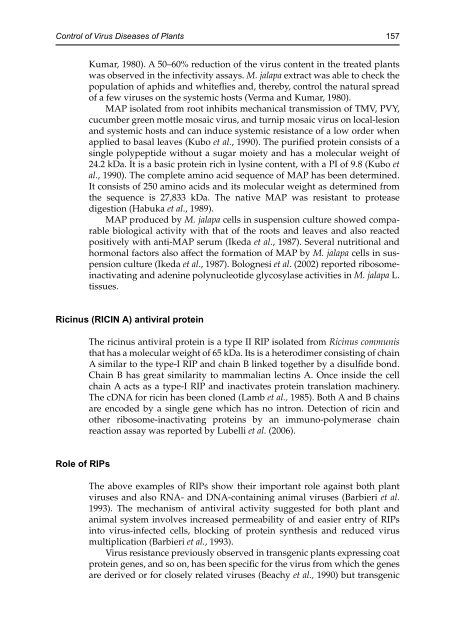natural-products-in-plant-pest-management
natural-products-in-plant-pest-management
natural-products-in-plant-pest-management
Create successful ePaper yourself
Turn your PDF publications into a flip-book with our unique Google optimized e-Paper software.
Control of Virus Diseases of Plants 157Kumar, 1980). A 50–60% reduction of the virus content <strong>in</strong> the treated <strong>plant</strong>swas observed <strong>in</strong> the <strong>in</strong>fectivity assays. M. jalapa extract was able to check thepopulation of aphids and whiteflies and, thereby, control the <strong>natural</strong> spreadof a few viruses on the systemic hosts (Verma and Kumar, 1980).MAP isolated from root <strong>in</strong>hibits mechanical transmission of TMV, PVY,cucumber green mottle mosaic virus, and turnip mosaic virus on local-lesionand systemic hosts and can <strong>in</strong>duce systemic resistance of a low order whenapplied to basal leaves (Kubo et al., 1990). The purified prote<strong>in</strong> consists of as<strong>in</strong>gle polypeptide without a sugar moiety and has a molecular weight of24.2 kDa. It is a basic prote<strong>in</strong> rich <strong>in</strong> lys<strong>in</strong>e content, with a PI of 9.8 (Kubo etal., 1990). The complete am<strong>in</strong>o acid sequence of MAP has been determ<strong>in</strong>ed.It consists of 250 am<strong>in</strong>o acids and its molecular weight as determ<strong>in</strong>ed fromthe sequence is 27,833 kDa. The native MAP was resistant to proteasedigestion (Habuka et al., 1989).MAP produced by M. jalapa cells <strong>in</strong> suspension culture showed comparablebiological activity with that of the roots and leaves and also reactedpositively with anti-MAP serum (Ikeda et al., 1987). Several nutritional andhormonal factors also affect the formation of MAP by M. jalapa cells <strong>in</strong> suspensionculture (Ikeda et al., 1987). Bolognesi et al. (2002) reported ribosome<strong>in</strong>activat<strong>in</strong>gand aden<strong>in</strong>e polynucleotide glycosylase activities <strong>in</strong> M. jalapa L.tissues.Ric<strong>in</strong>us (RICIN A) antiviral prote<strong>in</strong>The ric<strong>in</strong>us antiviral prote<strong>in</strong> is a type II RIP isolated from Ric<strong>in</strong>us communisthat has a molecular weight of 65 kDa. Its is a heterodimer consist<strong>in</strong>g of cha<strong>in</strong>A similar to the type-I RIP and cha<strong>in</strong> B l<strong>in</strong>ked together by a disulfide bond.Cha<strong>in</strong> B has great similarity to mammalian lect<strong>in</strong>s A. Once <strong>in</strong>side the cellcha<strong>in</strong> A acts as a type-I RIP and <strong>in</strong>activates prote<strong>in</strong> translation mach<strong>in</strong>ery.The cDNA for ric<strong>in</strong> has been cloned (Lamb et al., 1985). Both A and B cha<strong>in</strong>sare encoded by a s<strong>in</strong>gle gene which has no <strong>in</strong>tron. Detection of ric<strong>in</strong> andother ribosome-<strong>in</strong>activat<strong>in</strong>g prote<strong>in</strong>s by an immuno-polymerase cha<strong>in</strong>reaction assay was reported by Lubelli et al. (2006).Role of RIPsThe above examples of RIPs show their important role aga<strong>in</strong>st both <strong>plant</strong>viruses and also RNA- and DNA-conta<strong>in</strong><strong>in</strong>g animal viruses (Barbieri et al.1993). The mechanism of antiviral activity suggested for both <strong>plant</strong> andanimal system <strong>in</strong>volves <strong>in</strong>creased permeability of and easier entry of RIPs<strong>in</strong>to virus-<strong>in</strong>fected cells, block<strong>in</strong>g of prote<strong>in</strong> synthesis and reduced virusmultiplication (Barbieri et al., 1993).Virus resistance previously observed <strong>in</strong> transgenic <strong>plant</strong>s express<strong>in</strong>g coatprote<strong>in</strong> genes, and so on, has been specific for the virus from which the genesare derived or for closely related viruses (Beachy et al., 1990) but transgenic


